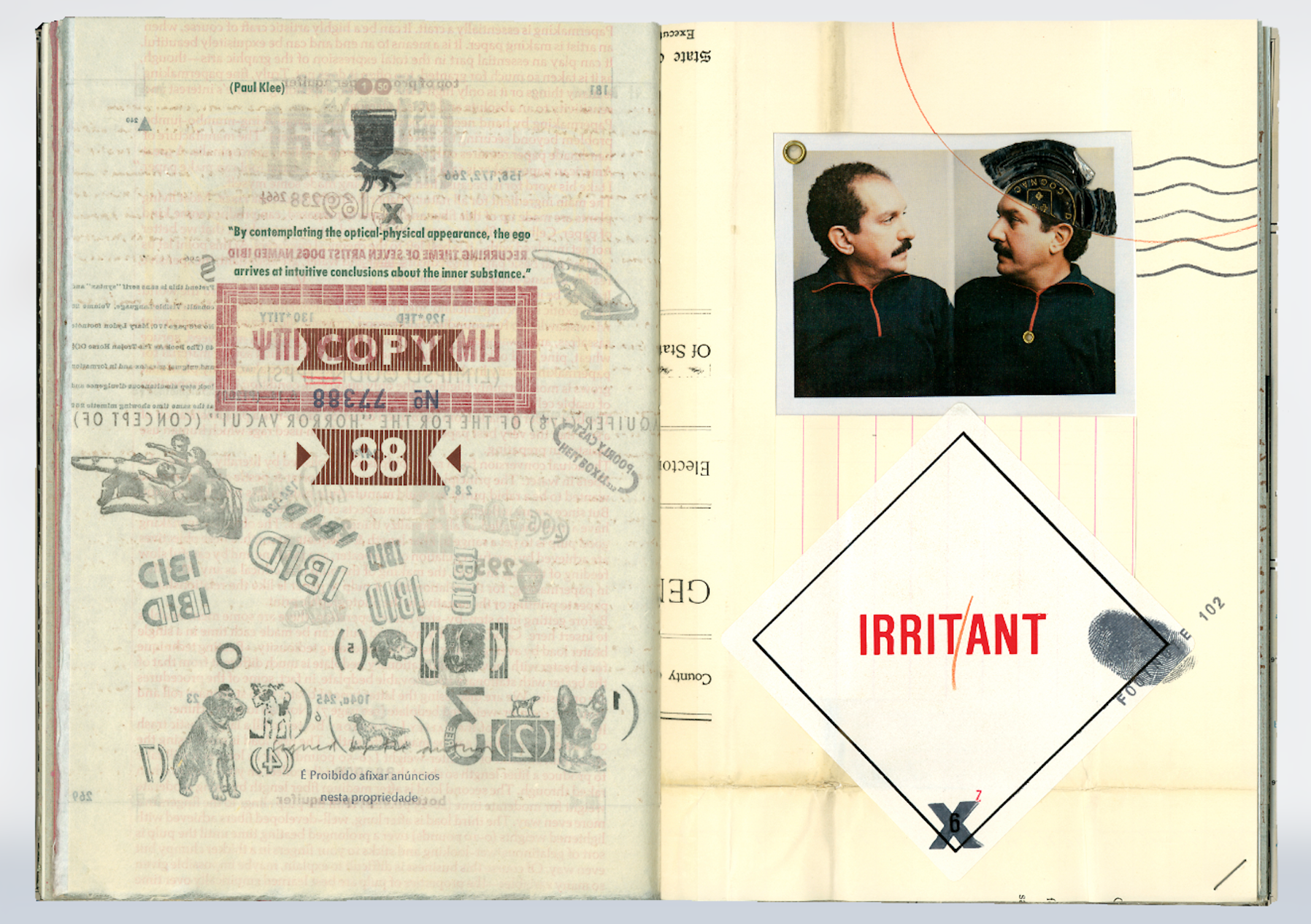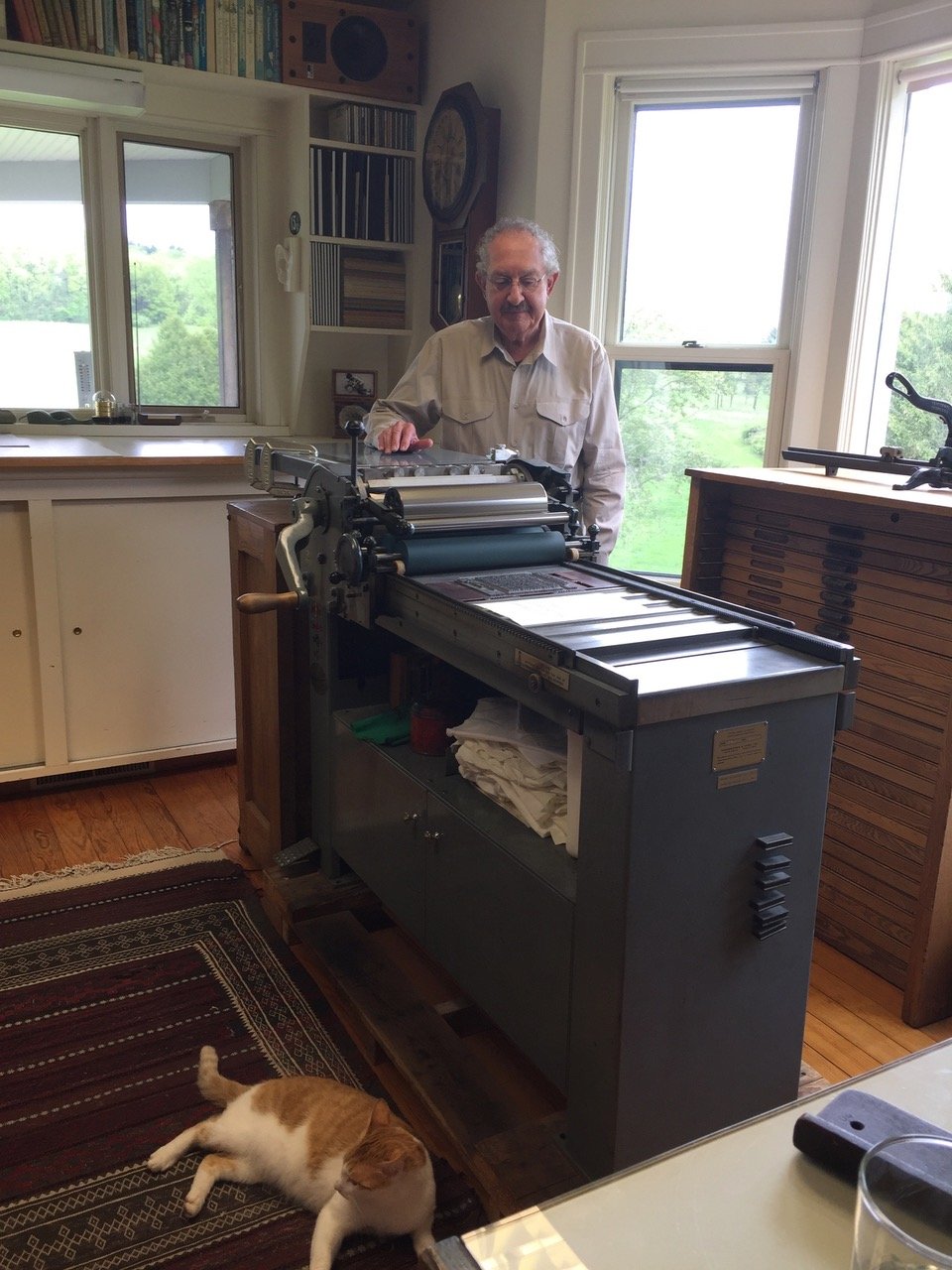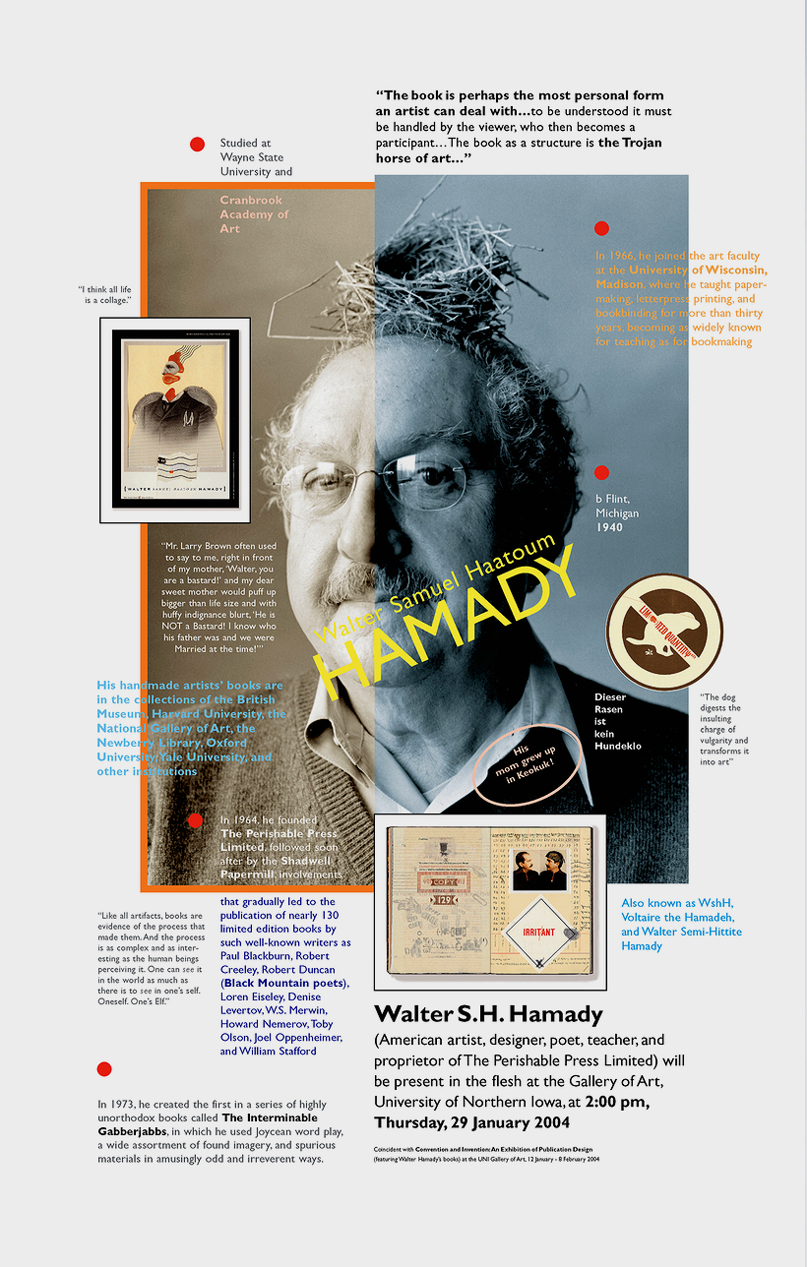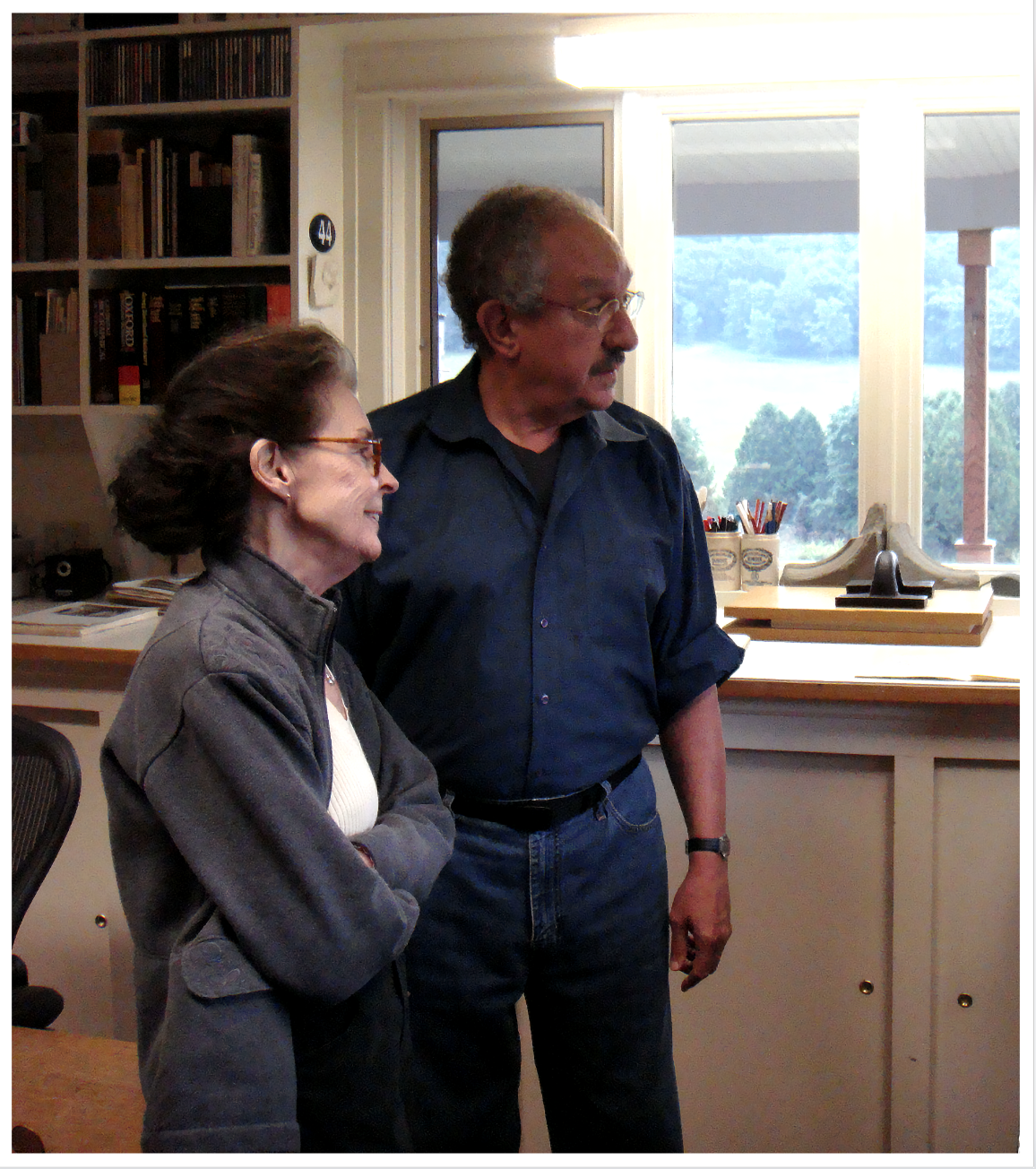
Walter Hamady
PAPERMAKING CHAMPION
1940-2019
Hand papermaker, teacher/professor, and fine and artist's book printer, Walter was professor at the University of Wisconsin-Madison for decades, teaching many paper artists and bookmakers who, in turn, had lifelong careers and connections to handmade paper and fine books.
Walter Hamady
A tribute to Walter Hamady by Roy. R. Behrens
There is an old story about Walter Hamady that appears to be in part untrue. Nevertheless, consistent with Walter’s own tendency to embellish stories, that has not prevented me from repeating it, even fine-tuning it slightly. It pertains to Walter’s hijinks as a maker of handmade paper.
To clarify, let’s first briefly set the stage: Walter was Walter (Samuel Haatoum) Hamady (1940–2019), an American artist, letterpress printer, papermaker, poet, collagist, and assemblagist, who taught for more than thirty years at the University of Wisconsin at Madison. In the early 1960s, while an undergraduate art student at Wayne State University, he met Harry Duncan on a visit to Iowa City. Inspired by Duncan’s letterpress books, Hamady launched a “private press” in 1964 called The Perishable Press Limited, by which he then went on to print limited-edition handmade books, called “artists books” (a term that he himself eschewed). In tandem with book printing, he was soon drawn into the challenge of making his own innovative papers, which resulted in his founding of the Shadwell Papermill in 1968, while still a student at Cranbrook Academy of Art.
Over a span of more than four decades, Walter published 131 letterpress books, in addition to various pamphlets, broadsides, and ephemera. The things he made were invariably inventive, and his printed works are widely known. Among numerous honors, he received a Guggenheim Fellowship, and three research awards from the National Endowment for the Arts. On thirteen occasions, his handmade books were chosen by the American Institute of Graphic Arts as among the AIGA Fifty Books of the Year, and, in one case, twice in the same year. His work is in collections throughout the world, including the Whitney Museum of American Art, Victoria and Albert Museum, Newberry Library, Grolier Club, National Gallery of Art, and a lengthy list of others.
Walter was also a much-storied teacher. An impressive number of his students at the University of Wisconsin went on to become proponents and practitioners of papermaking, letterpress printing, and innovative artist books. It is essential to keep in mind that he taught not only skills, techniques, and craftsmanship. It was high on his list of distinctions that he fostered experimentation, and applauded the breach of traditions.
As an artist as well as a teacher, he placed unusual emphasis on collaboration. Indeed, it could be argued that one key to his unusual success was the ingenuity with which he sought opportunities to include in his books the work of some of the finest writers of our time: Clarence Major, W.S. Merwin, Diane Wakoski, Allen Ginsberg, Loren Eiseley, Denise Levertov, and Paul Auster, to name a few. In the same spirit, he also reached out to accomplished visual artists, such as Jack Beal, John Wilde, Lane Hall, Jim Lee, Henrik Drescher, and Patrick JB Flynn, to use their work to complement the stories and poems of the writers. Walter was versatile, to say the least. He was especially capable of conjoining art and literature because he was an artist and poet, as much as he was a papermaker and letterpress printer.
But now to return to the story that I alluded to before. Walter’s and my friendship began in 1994. A few years earlier, I had returned to Iowa to teach, while Walter was headed toward retirement from his own teaching position in Madison. Having taught in Milwaukee in earlier years, I was well aware of his artwork, but we were never in contact.
One day I impulsively sent him an issue of a self-published magazine I had begun in 1985, called BALLAST Quarterly Review. Like his books, it too blended writing with art, as had the Vorticist magazine BLAST. It was, as I described it then, a “periodical commonplace book,” a medley of curious snippets from the published writings of others. Walter replied with a generous, energized letter, and, from that day on, we embarked on a flurry of missives that continued for nearly two decades. It eventually resulted in essays, exhibitions, studio visits, and speaking invitations.
In 1996, he began to work on a new, major letterpress book, titled Traveling, with the effusive subtitle of NeoPostModrinPreMortemism or Dieser Rasen ist kein Hundeklo (II) or Interminable Gabberjabb Number Seven. It was the latest volume in a series he called Gabberjabbs, the first of which he had published in 1973. Each Gabberjabb was a Hamady tour de force, a showcase of his daring as a papermaker, typographer, and book artist. With each book in the series, these grew increasingly irreverent, eccentric, and unorthodox, and today he is probably no better known than for these mind-boggling triumphs in paper and ink.
Fifteen years earlier, I had published a book on camouflage, a subject by which Walter was forever amused. By 1996, it was out of print and hard to find, which proved a temptation for Walter. He informed me that he would be shredding that book, in order to make paper for the pages of his own new Gabberjabb. Nothing could be more appropriate, he reasoned, than to “camouflage” my book on camouflage in the pages of his. I was of course delighted.
Alas, when a copy of Traveling arrived, I found on one of its pages a typeset notation bearing my name and the word “camouflage” (“in a nearly camouflaged gray at the top”) followed by footnote 396. That page was printed on the handmade paper he made from the punched-out confetti remains of my book. Or so I had been led to believe.
That is the story I’ve shared for years. But now it seems it isn’t true. I have recently reread a letter he wrote in which, in considerable detail, he describes the labyrinth of steps he used in producing the paper for that page, “…I took your book,” he misleadingly states, “dismembered it, took the illustrations & randomly punched them with ticket punchers, mixed those shapes in with the others and added them to the pulp. Voila! Camouflaged!!” But I have since discovered that in fact he did not use my book. Instead, he used the pages from the first chapter when it was published in the North American Review, in advance of the book’s publication.
His letter continues. After explaining further about the process of making paper, he pauses to ask: “Does this make sense?…If you want to know more about papermaking by hand you could: 1) visit Tim Barrett’s at Iowa City & watch; 2) you could watch videos; 3) you could visit here sometime when I’m doing it, though I don’t know when next for sure. Whew!”
In Walter Hamady’s letterpress books, paper plays a more pivotal role than most people realize—and that is especially true perhaps of viewers who themselves have never made paper. Unlike letterforms, colors, and shapes, the surest way to appreciate the rich nuances of paper is not by using the eyes alone, but by touch and vision combined. It is not sufficient to look at non-tactile reproductions of books from The Perishable Press Limited. Better yet, they must be touched, and, whenever possible, they should be cradled in the hand.
There is no more vivid, immediate way to witness the marvelous feel of the tooth on the imprinted sheet, or to ride with the islands of ink as they rise. If well-equipped with vision and touch, we can anticipate turning the page to the next welcome surprise—the next startling Jabb from the Gabber.
Roy R. Behrens is not a papermaker. He is a designer, writer, and retired university professor, who taught graphic design and design history at American art schools and universities for 46 years. He has authored seven books and hundreds of essays and articles in research journals, magazines, and encyclopedias. He was for many years the art editor of the North American Review, contributing editor for PRINT magazine, and the founding editor of BALLAST Quarterly Review. His earlier writings about Walter Hamady and The Perishable Press Limited can be accessed online here.

Become an NAHP Member
Join our vibrant hand papermaking community and access your membership benefits.


























